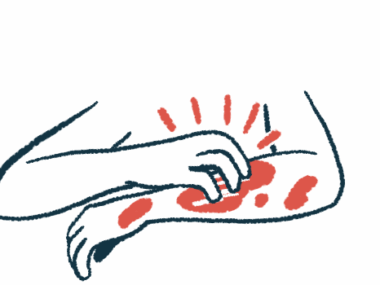Dupilumab seen to heal blisters in epidermolysis bullosa acquisita
Case report details complete healing with injection therapy in woman, 51
Written by |

Treatment with dupilumab, an injection therapy approved for certain inflammatory disorders, was found to completely heal blistering in a woman in Germany with epidermolysis bullosa acquisita (EBA), a case report describes.
The woman’s healing with dupilumab came after “different systemic treatments … remained ineffective,” the researchers wrote. Indeed, the patient had refused the use of any further immunosuppressive treatments “due to the side effects,” they noted.
According to the team, “the successful long-term effect of dupilumab in our patient opens up the prospect of its application in different types of [autoimmune blistering disorders].”
The report, “Treatment of Epidermolysis bullosa acquisita with dupilumab,” was published as a letter to the editors of JDDG: Journal der Deutschen Dermatologischen Gesellschaft.
Treatment with prednisolone plus topical steroids ineffective in this case
EBA is an autoimmune type of epidermolysis bullosa caused by self-reactive antibodies, or autoantibodies, against the protein type VII collagen. Their attack leads to the loss of anchoring, or attachment, between two skin layers — the epidermis at the top and the dermal layer underneath — which promotes blisters.
Treatment for the condition depends on disease severity and on the involvement of mucous membranes, the tissue that lines body cavities such as the mouth, nose, and eyes. It can involve whole-body (systemic) corticosteroids, immunosuppressive agents, or an antibiotic known as dapsone. However, efficacy may be limited. Further, the use of immunosuppressants is linked with side effects, such as a higher susceptibility to infection.
Now, a team from the University of Freiburg described the case of a woman with EBA who showed marked improvements following off-label treatment with dupilumab.
The patient, age 51, was diagnosed with EBA following a five-year history of itching and scarring in a breast and in her hands. A routine blood test confirmed the presence of antibodies against VII collagen.
She received treatment with oral prednisolone, a corticosteroid, along with the immunosuppressive agents azathioprine and rituximab (sold in the U.S. as Rituxan and biosimilars), in combination with topical steroids. However, the treatment was ineffective.
After the patient refused further immunosuppressive therapy due to the side effects, the clinicians considered off-label treatment — using a medication for an indication for which it was not approved by regulators — with dupilumab.
Findings warrant research into dupilumab for epidermolysis bullosa acquisita
An antibody-based medication, dupilumab works by blocking the activity of interleukin-4, an inflammatory molecule involved in immune reactions.
The therapy is approved as Dupixent (sold by Regeneron Pharmaceuticals and Sanofi) for certain inflammatory conditions including atopic dermatitis, or eczema. Based on the treatment regimen used in eczema, the patient received dupilumab along with topical mometasone furoate cream, a corticosteroid, for a short period.
Significant improvements were seen within three months, with skin blistering completely resolved. This was accompanied by lower levels of autoantibodies. Based on these findings, the woman’s health insurance company covered the treatment for one year.
Our findings provide preliminary evidence warranting continued investigation [of dupilumab for treating EBA].
At the last follow-up before the study’s conclusion, no side effects or disease progression were observed.
This case report adds to other studies supporting the therapeutic potential of dupilumab for epidermolysis bullosa. Importantly, because EBA has been considered a risk factor for cancer in the liver and bile duct, “dupilumab would be a safe option when immunosuppression is not tolerated or not possible,” the researchers wrote.
Given that this was a case study, “additional research in larger patient cohorts is required to further evaluate the efficacy of dupilumab before general conclusions about clinical benefit can be made,” the team wrote. “Our findings provide preliminary evidence warranting continued investigation.”







